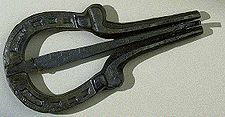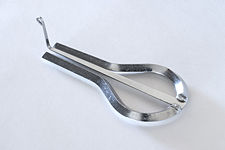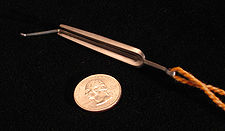
Jew's harp
Encyclopedia



Musical instrument
A musical instrument is a device created or adapted for the purpose of making musical sounds. In principle, any object that produces sound can serve as a musical instrument—it is through purpose that the object becomes a musical instrument. The history of musical instruments dates back to the...
s in the world; a musician apparently playing it can be seen in a Chinese drawing from the 4th century BC. Despite its common English name, and the sometimes used Jew's trump, it has no particular connection with the Jewish people
Jews
The Jews , also known as the Jewish people, are a nation and ethnoreligious group originating in the Israelites or Hebrews of the Ancient Near East. The Jewish ethnicity, nationality, and religion are strongly interrelated, as Judaism is the traditional faith of the Jewish nation...
or Judaism
Judaism
Judaism ) is the "religion, philosophy, and way of life" of the Jewish people...
. This instrument is native to Asia and used in all tribes of Turkic peoples
Turkic peoples
The Turkic peoples are peoples residing in northern, central and western Asia, southern Siberia and northwestern China and parts of eastern Europe. They speak languages belonging to the Turkic language family. They share, to varying degrees, certain cultural traits and historical backgrounds...
in Asia where it is variously referred to as a temir komuz (literally, iron komuz), agiz komuzu (literally, mouth komuz) or gubuz.
The instrument is known in many different cultures by many different names. The common English name "Jew's harp" may be considered controversial or potentially misleading, and is thus avoided by some speakers. Another name used to identify the instrument, especially in scholarly literature, is the older English
English language
English is a West Germanic language that arose in the Anglo-Saxon kingdoms of England and spread into what was to become south-east Scotland under the influence of the Anglian medieval kingdom of Northumbria...
trump, while guimbarde, the French word for the instrument, can be found in unabridged dictionaries and is featured in recent revival efforts.
The instrument is a lamellophone, which is in the category of plucked idiophones
Plucked idiophones
Plucked idiophones is one of the categories of musical instruments found in the Hornbostel-Sachs system of musical instrument classification that is usually referred to as . These idiophones are equipped with one or more tongues or lammelae that produce sound by being plucked by the performer...
: it consists of a flexible metal
Metal
A metal , is an element, compound, or alloy that is a good conductor of both electricity and heat. Metals are usually malleable and shiny, that is they reflect most of incident light...
or bamboo
Bamboo
Bamboo is a group of perennial evergreens in the true grass family Poaceae, subfamily Bambusoideae, tribe Bambuseae. Giant bamboos are the largest members of the grass family....
tongue or reed attached to a frame. The tongue/reed is placed in the performer's mouth and plucked with the finger to produce a note. The frame is held firmly against the performer's parted front teeth, using the jaw (thus "jaw harp") and mouth as a resonator, greatly increasing the volume of the instrument. The teeth must be parted sufficiently for the reed to vibrate freely, and the fleshy parts of the mouth should not come into contact with the reed to prevent damping of the vibrations. The note thus produced is constant in pitch
Pitch (music)
Pitch is an auditory perceptual property that allows the ordering of sounds on a frequency-related scale.Pitches are compared as "higher" and "lower" in the sense associated with musical melodies,...
, though by changing the shape of his or her mouth and the amount of air contained in it (and in some traditions closing the glottis
Glottis
The glottis is defined as the combination of the vocal folds and the space in between the folds .-Function:...
) the performer can cause different overtone
Overtone
An overtone is any frequency higher than the fundamental frequency of a sound. The fundamental and the overtones together are called partials. Harmonics are partials whose frequencies are whole number multiples of the fundamental These overlapping terms are variously used when discussing the...
s to sound and thus create melodies
Melody
A melody , also tune, voice, or line, is a linear succession of musical tones which is perceived as a single entity...
. The volume of the note can be varied by breathing in and out.
Since trance
Altered state of consciousness
An altered state of consciousness , also named altered state of mind, is any condition which is significantly different from a normal waking beta wave state. The expression was used as early as 1966 by Arnold M. Ludwig and brought into common usage from 1969 by Charles Tart: it describes induced...
s are facilitated by droning sounds, the Jew's harp has been associated with magic
Magic (paranormal)
Magic is the claimed art of manipulating aspects of reality either by supernatural means or through knowledge of occult laws unknown to science. It is in contrast to science, in that science does not accept anything not subject to either direct or indirect observation, and subject to logical...
and has been a common instrument in shamanic rituals.
The temir komuz is made of iron usually with a length of 100- 200mm and with a width of approximately 2- 7mm. The range of the instrument varies with the size of the instrument, but generally hovers around an octave
Octave
In music, an octave is the interval between one musical pitch and another with half or double its frequency. The octave relationship is a natural phenomenon that has been referred to as the "basic miracle of music", the use of which is "common in most musical systems"...
span. The Kirgiz people are unusually proficient on the temir komuz instrument and it is quite popular among children. However, some adults continue to play the instrument. There is a National Artist of Kyrgyz Republic who performs on the instrument, temir komuz. One time twenty Kirgiz girls played in a temir komuz ensemble on the stage of the Bolshoi Theater in Moscow. Temir komuz pieces was notated by Zataevich in two or three part
Part
Part may refer to:*Part *Part , a relation in mereology*Part , the music played or sung by an individual instrument or voice*Parts , a 1997 children's book by Tedd Arnold...
s. Apparently an octave
Octave
In music, an octave is the interval between one musical pitch and another with half or double its frequency. The octave relationship is a natural phenomenon that has been referred to as the "basic miracle of music", the use of which is "common in most musical systems"...
drone is possible, or even an ostinato
Ostinato
In music, an ostinato is a motif or phrase, which is persistently repeated in the same musical voice. An ostinato is always a succession of equal sounds, wherein each note always has the same weight or stress. The repeating idea may be a rhythmic pattern, part of a tune, or a complete melody in...
alternating the fifth
Fifth
Fifth is the ordinal form of the number five.Fifth may refer to:* Fifth Amendment to the United States Constitution, as in the expression "Pleading the Fifth"* Fifth column - a political term...
step of a scale
Musical scale
In music, a scale is a sequence of musical notes in ascending and descending order. Most commonly, especially in the context of the common practice period, the notes of a scale will belong to a single key, thus providing material for or being used to conveniently represent part or all of a musical...
with an octave
Octave
In music, an octave is the interval between one musical pitch and another with half or double its frequency. The octave relationship is a natural phenomenon that has been referred to as the "basic miracle of music", the use of which is "common in most musical systems"...
.
Etymology
There are many theories for the origin of the name Jew's harp. One proposed explanation is that it is a corruption of "jaws harp", while a less likely explanation espoused by some is that its name comes from "juice harp" from the amount of salivaSaliva
Saliva , referred to in various contexts as spit, spittle, drivel, drool, or slobber, is the watery substance produced in the mouths of humans and most other animals. Saliva is a component of oral fluid. In mammals, saliva is produced in and secreted from the three pairs of major salivary glands,...
produced when played by inexperienced players. While the "jaw" variant is attested at least as early as 1774 and 1809 , the "juice" variant appeared only in the late 19th and 20th centuries. It has also been suggested that the name derives from the French "Jeu-trompe" meaning "toy-trumpet".
The Oxford English Dictionary
Oxford English Dictionary
The Oxford English Dictionary , published by the Oxford University Press, is the self-styled premier dictionary of the English language. Two fully bound print editions of the OED have been published under its current name, in 1928 and 1989. The first edition was published in twelve volumes , and...
calls theories that the name is a corruption of "jaws" or "jeu" "baseless and inept" and goes on to say, "More or less satisfactory reasons may be conjectured: e.g. that the instrument was actually made, sold, or sent to England by Jews, or supposed to be so; or that it was attributed to them, as a good commercial name, suggesting the trumps and harps mentioned in the Bible."
Use
Turkic traditional music
The instrument is also used by Sakha or YakutYakuts
Yakuts , are a Turkic people associated with the Sakha Republic.The Yakut or Sakha language belongs to the Northern branch of the Turkic family of languages....
people and Tuvanss with the name xomus.
Sindhi music
In Sindhi the Jaw harp is called Changu (چنگُ). In Sindhi music, it can be an accompaniment or the main instrument. One of the most famous players is Amir Bux Ruunjho.World music
The Jew's harp is frequently to be found in the repertoire of music played by alternative or world musicWorld music
World music is a term with widely varying definitions, often encompassing music which is primarily identified as another genre. This is evidenced by world music definitions such as "all of the music in the world" or "somebody else's local music"...
bands. Sandy Miller of the UK-based Brazilian samba/funk band Tempo Novo, plays a Jew's harp solo in the piece Canto de Ossanha.
Western Classical Music
The Austrian composer Johann Albrechtsberger—chiefly known today as a teacher of Beethoven—wrote several concerti for Jew's harp in the mid-1760s.
See also
- MorsingMorsingA morsing is a wind percussion instrument, mainly used in the Carnatic music of South India and Sindh . It can be categorized under lamellophones, which is in the category of plucked idiophones...
, a kind of Jew's harp from IndiaIndiaIndia , officially the Republic of India , is a country in South Asia. It is the seventh-largest country by geographical area, the second-most populous country with over 1.2 billion people, and the most populous democracy in the world... - Đàn môiĐàn môiĐàn môi is the Vietnamese name of a traditional musical instrument widely used in minority ethnic groups in Vietnam. This instrument is somewhat similar to the jaw harp but there are some differences. Most Đàn môi are crafted out of a single piece of brass and attached with a string to a...
another kind of Jew's harp from VietnamVietnamVietnam – sometimes spelled Viet Nam , officially the Socialist Republic of Vietnam – is the easternmost country on the Indochina Peninsula in Southeast Asia. It is bordered by China to the north, Laos to the northwest, Cambodia to the southwest, and the South China Sea –... - GogonaGogonaThe gogona is a type of jaw harp, a vibrating reed instrument that is used primarily in the traditional Bihu music in Assam. It is made of a piece of bamboo/horn that has a bifurcation on one end...
, a similar instrument played by Assamese peopleAssamese peopleThe Assamese people are a well-defined subgroup of People of Assam. Though sometimes they are defined as the Assamese-speaking Indo-Aryans of the Brahmaputra valley,, this definition is not legally binding...
(especially women) while singing and dancing BihuBihuBihu denotes a set of three different cultural festivals of Assam and celebrated by the Assamese diaspora around the world. Though they owe their origins to ancient rites and practices they have taken definite urban features and have become popular festivals in urban and commercialized milieus in...
- Music of Central AsiaMusic of Central AsiaCentral Asian music encompasses numerous different musical styles originating from a large number of Asian cultures. Central Asian music most often uses the pentatonic scale....
- Music of SicilyMusic of SicilyThe Music of Sicily refers to music created by peoples from the isle of Sicily. It was shaped by the island's history, from the island's great presence as part of Magna Grecia 2,500 years ago through various historical incarnations as past of the Roman Empire, then an integral part of the Kingdom...
- Temir komuzTemir komuzThe temir komuz can be introduced as a Kirgiz jaw harp, while the komuz is another kind of musical instrument, a 3-stringed fretless lute...
- Agiz komuzuTemir komuzThe temir komuz can be introduced as a Kirgiz jaw harp, while the komuz is another kind of musical instrument, a 3-stringed fretless lute...
- GubuzTemir komuzThe temir komuz can be introduced as a Kirgiz jaw harp, while the komuz is another kind of musical instrument, a 3-stringed fretless lute...
External links
- Hawaiian Jew's Harp The 'Ukeke, Indigenous Hawaiian string instrument played with the mouth, sound clips.
- The Jew's Harp Guild
- How to play the jew's harp (instructions with sound examples and remarks on the functioning of Jew's harps)
- A page on guimbardes from Pat Missin's free reed instrument website
- Origins of the Jew's Harp. A popular synopsis of the archaeological findings of Jew's harps combined with an extensive illustrated survey of the world distribution of different types.
- Jewsharper Jews harp history, news and tutorials from Michael Wright, of Oxfordshire, UK
- Demir-xomus (Tuvan Jew's Harp) Demos, photos, folktale, and text

